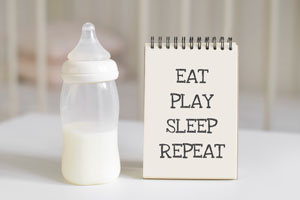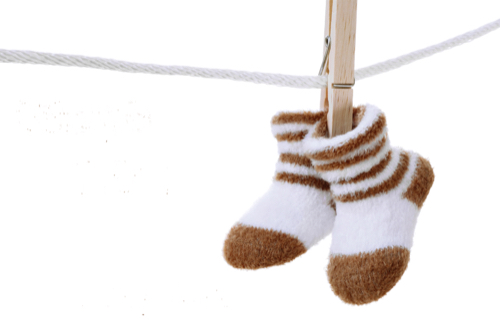Curriculum for the Newborn Care Specialist Course
As you can see, it is NOT a basic course but includes many advanced subjects. Notice we are also the only course that includes a complete class on how to successfully start your own business (The ABC's of Starting your Business) and how to start a consulting business. This Curriculum is from the full-color manual that you receive if you order it with the class. The video class does not contain the numerous charts, grafts, illustrations, and articles the manual contains. Our classes use live demonstrations of techniques. This course covers newborns to 12 weeks of age.

CLASS 1:
WHAT IS A NEWBORN CARE SPECIALIST?
- Job Description
- Compensation
- What is an intern
- Certification
HOW TO MARKET YOURSELF
Many ways to get yourself started working
NURSERY NECESSITIES
A list to help clients to choose the right items for baby
NURSERY SUGGESTIONS
This is a comprehensive list of the necessities and how to use them
FETAL DEVELOPMENT MONTH BY MONTH
NEWBORN'S APPEARANCE
- 5 Senses
- Birthmarks\
- Apgar Scale
- Genitals
- Umbilical cord
- Fontanels
- Nasoaxillary Reflex
- Skin Irregularities
PREMATURE BABY CARE
- Feeding
- Swaddling
- Holding and Feeding
- Physical Signs of Discomfort
- Adjusted age explained
KANGAROO CARE
- What is Kangaroo Care
- How to do Kangaroo Care
- Who can do Kangaroo Care
- Benefits of Kangaroo Care
MILESTONES 0 – 3 MONTHS
BABY'S IMMUNIZATIONS
- Chart of what vaccines are required at what age
NEWBORN REFLEXES
- Top Eleven Primitive reflexes
TONGUE OR LIP TIE
- Signs in parents
- Signs in baby
- Accessing
- How to check for tongue-tie
SUCKING BLISTERS
- Defined
TORTICOLLIS'
- Defined
- Signs in the baby
- Accessing the issue
- Treatment
HOME WITH NEWBORN
- Care of the uncircumcised and circumcised penis
- Umbilical cord care
- Recommended Clothing
- Diapering
BATH TIME
- Sponge Baths
- Womb Bath
- Swaddled Bath
BABY MASSAGE

CLASS 2
CRYING AND SOOTHING
- We will teach you how to become the "Baby Whisperer."
WHY DO BABY'S CRY?
- Eleven reasons why babies cry and what we can do to help them.
- Cry-it-out pros and cons
READING A BABY'S SIGNS
- How to know what a baby needs by reading them
- Physiological, Motor, State, and Self Regulations
SOOTHING TECHNIQUES
- Dr. Karp's Soothing Methods are discussed, and teaching a baby how to self soothe
SWADDLING PERFECTED
- History
- Swaddling today
- Swaddling a systematic review
- 8 Reasons Parents will give not to swaddle
- Benefits of swaddling
- When to stop swaddling
- Breakout baby
- Common swaddling mistakes
- The transition from swaddling
- Swaddling techniques demonstrated

CLASS 3
GIFT OF SLEEP Sleep Conditioning is a method we use to get a baby to sleep without using the harsher cry-it-out methods. This is a gentle day-by-day method, and you will learn the process here.. We walk you through an entire night and day to show you pointers to use to have a happy baby and mommy. Included in this class is also sleep training. This is the most requested service of the Newborn Care Specialist. We do not charge an additional charge for this coveted glass.
- Sleep explained
- Sleep Conditioning
- Sleep Training
- Sleep Explained
- Circadian Clock
- Red Light
- White Noise Machines and their benefits
- Sleepy Signs
- Biological Clocks
- Research on the Best Methods to Sleep Train
- Articles on Why Not Enough Sleep is Dangerous
- Rules to Sleep By
- Hints for Sleep Conditioning
- Feeding Guidelines for Sleeping Babies
- Dream Feeds
- Newborn Naps
- Self-Soothing the French Way
- Sleep Training Dr. Cohen’s Method
- Daytime Activity
- Miscellaneous Sleep Training Methods – Tried and True
- Sleep Training for an 8-month-old
- Sleep Crutches
- Develop a Sleep Training Plan
- Cry It Out To Do or Not to Do
- 6 articles in the manual for your reference
CONSULTATIONS
- Do a Consultation for Sleep Training or newborn care
- What to Charge for Consultations
- How To Get Paid for a Consultation
- How Not to Give Away Your Information and Still Get the Business

CLASS 4
MULTIPLES:
- Scheduling
- Co-Sleeping
- Feeding
- Sleep Conditioning
- Logs
POOP:
- What’s Normal
- Meconium
- Bottle-Feeding/Breast-Feeding Baby
- Poop
- Warning Signs
- What to do with Constipation
- Diarrhea
SCHEDULING:
- Demand
- Scheduled and Responsible Schedules
- Routine Four – Over Six Pounds
- How to Create a Baby Log
- Newborn Naps From Four – Six Months
- Daytime Nap Routine
- Daily Wake
- Play Feed Chart up to 12 months
- Daily Sleep Chart
- Schedule Newborn to Eight Weeks
PACIFIERS:
- AAP Decision
- How to Use
- When to Use
- When to Pull the Plug
- Pros and Cons.

CLASS 5
FORMULAS
If you are interested in the health of newborns, this chapter is fascinating. Ms. Hamm has researched formulas and understands the dangers of feeding our babies chemicals and sugars. You will have a working knowledge of the ins and outs of formula feeding. What does organic mean, and does it mean what you think? We will give you suggestions on healthy formulas. We will also cover all other aspects of feeding with a bottle.
ARE ALL FORMULA'S FDA APPROVED?
TYPES OF FORMULAS DISCUSSED
- Milk-Based
- Soy-Based
- Lactose Based
- Hypoallergenic
- Special Needs
- What is Organic
- Why Organic is Not Organic Any More
- Dangers of Soy Formula
- DHA/ARA Dangers
- GMO in Formula
- Sugar in Formula
GOAT'S MILK
- Is it Safe
- Recommended
- Compared to Cow's milk
DAIRY OR LACTOSE INTOLERANCE
- Dairy Allergy vs. Daily Hypersensitivity
- Lactose Intolerance
- Signs of Milk Allergies
- Importance of Iron Fortified Formula
- Comparison of the Most Popular Formulas
USING AND CLEANING BOTTLES
- Buying Bottles and Nipples
- Cleaning Bottles
- Warming Bottles
FEEDING BABY
- Water to Use When Making Formula
- Direction on How to Make Formula
- How Much to Feed
- How Often to Feed
- When to Feed
- Is Baby Getting the Correct Amount
- Over-Feeding- Under-Feeding Signs
- Guidelines for Weight Gain
- Newborn Schedule for Feeds
- The First Three Days
- Methods for Burping
- When to Burp
- When Burping is Enough
TYPES OF FORMULAS
- Concentrate
- Ready to Feed
- Powder
- Switching Formulas
- Sterilizing Bottles
- Comparing Breast Milk with Formula
- Feeding Guidelines from three days to four months
- Bottle-Feeding a Breast-Fed Baby.

CLASS 6
BREASTFEEDING
Breastfeeding is the best way to feed a baby. We will cover all aspects of breastfeeding, from positions to breastfeeding difficulties. You will understand what problems can arise and how to meet them head-on. You will learn on the breast works and how to boost the milk supply
- Why is Breastmilk so Good
- Process of Breastmilk Production
- Supply and Demand
- How to Increase Supply
- Breastfeeding Difficulties
- Cradle Hold
- Cross Cradle
- Football Hold
- Side Hold
- Natural Breastfeeding – Positioning
- Pressure Points, Breastfeeding Tips
- Tips for Large Breasted Mothers
- Wake up Baby to Feed
- Perfect Latch
- C-Hold
- How Often
- How Long to Breastfeed
- Calories for a BreastFeeding Mom
- How to Tell if Baby is Getting Adequate Breastmilk
- Should a Baby Eat More Than Every Three Hours, Nipple Confusion
- How to Avoid Nipple Confusion
- Should you Introduce a Bottle
- If so when
- What is Power Pumping
- Caring for the Breast
ENGORGEMENT
- Signs, How to Treat
- Prevention
- How to Nurse while Engorged
- Sore Nipples
PLUGGED DUCTS
- Symptoms
- Treatment
- While Nursing
- Natural Remedies
MASTITIS
- Symptoms, Prevention
- Treatment
- While Nursing
- Increasing Milk Supply
- Sour Smelling Breast Milk
CANDIDA
- How to Treat
- Prevention
- Symptoms
- Gas-Producing Foods
- Guidelines for Storing Breastmilk
- Containers to use
- How to Warm and How to Thaw.

CLASS 7
REFLUX AND COLIC
Colic is perhaps one of the most misunderstood abnormalities that a newborn can experience, and reflux one of the most frustrating. We will cover both of these in an easy-to-understand class. We will offer solutions and preventatives for both ailments.
REFLUX
- Defined
- Nocturnal Reflux
- Silent Reflux
- Symptoms
- Natural Remedies
- Medications
- Breastfeeding and Reflux
- Causes of Reflux
- Formula and Reflux
COLIC
- What is Colic
- Minor and Major GI Disorders
- Over-Stimulation
- Biological Clock
- Gas and Digestion Issues
- Natural Ways to Soothe Colic

CLASS 8
WARNING SIGNS
This is one of the important classes we offer. We discuss how to tell if a newborn is experiencing illness and what to do. We talk about diaper rashes, their cause, and preventative measures.
- Is the Newborn in Trouble
- Taking a Temperature – rectal, axillary, forehead, and ear
- When a Baby Has a Fever
- What to Tell the Pediatrician
- When to Call the Dr.
- How to Lower a Temperature
- Medicine Consent Form
- Projectile Vomiting
- How to Treat a Cold
- Using the Vaporizer
- Hot or Cool Mist
- Cleaning, Placement
- Nasal Discharge
- Nasal Aspirator
- Administrative Medications
- Oral
- Ear
- Eye
- Diaper Rash Names
- Diaper Rash Cheat Sheet
- Symptoms
- Treatment
- Natural Remedies
- Make Your Own Diaper Wipes
- Preventing Diaper Rash
- When to Call the Doctor.
- Thrush
- What is Thrush
- When to call the Dr.
- Natural Remedies
- Chemicals:
- Chemicals in Baby’s Products
- Causes of Infertility
- Chemicals to Avoid
- Chemical Affect Baby’s Life
- Chemical Uses and Dangers
- Natural Substitutes for Chemical Products.

CLASS 9
AILMENTS, SAFETY, AND POSTPARTUM DEPRESSION
his is a class that covers the types of common illnesses that a newborn can experience and what to do about them. We cover SIDS, acne, cradle cap, positional plagiocephaly, shaken baby syndrome, jaundice, RSV, and more. We talk about safety and what items to use, and how to use them for the safety of the infant. Postpartum Depression, including Baby Blues and Postpartum Psychosis, is discussed in detail.
AILMENTS
- Cradle Cap
- Signs and treatment
- Baby Acne
- Signs and treatment
- Shaken Baby Syndrome
- Signs and treatment
- Positional Plagiocephaly
- Signs and treatment
- Jaundice
- Signs and treatment
- Sudden Infant Death Syndrome (SIDS)
- RSV
- Signs and treatment
Newborn Safety
- Bedding
- Cribs and toys
- Pacifiers
- Changing Tables
- Infant seats and Bouncy’s
- Swing Safety
- Decorating for Safety
- General Safety for any Room
POSTPARTUM
- Stages of Postpartum
- PPD defined
- Difference between PPD, Baby Blues and Postpartum Psychosis
- What is Postpartum Psychosis
- Recognize
- Helping someone with PPD
- What to do if your client does not realize she has PPD.
- Questions to ask the Doctor
- Edinburgh Postnatal Depression Scale is included.
- Can Fathers have PPD?

CLASS 1O
This class tugs at my heartstrings as it deals with the things that are not common but are very necessary for the Newborn Care Specialist to become familiar with. Gentle Ventures is the only class that I am aware of that teaches some of these subjects. Death of an Infant, Failure to Thrive, and A Baby’s Mind and Communication. As an NCS, you will need to be able to communicate with your clients in an effective manner. This class will open doors for you.
Failure to Thrive
- Organic and Inorganic causes
- Symptoms
- Treatment
Death of a Child
- Stages of Grief
- What NCS can do
- Baby Dies in Hospital or Before Birth
A Baby’s Mind
- Conscious and Unconscious Mind
- Development of a Child’s Mind from 0 – 6 years
- How a Child Learns
Communication
- Communication Styles
- 30-second introduction
- How to Communicate Effectively with Clients

CLASS 11
ETHICS FOR NEWBORN CARE SPECIALIST
This class is our Ethics class. It is packed with information on how to be a professional Newborn Care Specialist. We will show you how to create a professional resume, portfolio, what is proper.
THE INTERVIEW
- Time
- Directions
- Before the Interview
- How to Dress
- Thank You Note
- Nails
- Hair
- Makeup
- Uniform
- Mistakes in Interview
FACEBOOK AND TWITTER
PORTFOLIO
- Blinder
- What to Include
- What Not to include
- Resumes
- References
- Order of Portfolio
THINGS CLIENTS LOOK FOR
ON THE JOB PROTOCOL
CONFIDENTIALITY
ON THE JOB PROTOCOL
- Food on the Job
- Problem Solving
- I’m Sick
- Billing Invoice
- How to Collect Your Salary
- On the Job Appearance
- Exit Letter
- Contracts
- Terms not Amicable
TAXES
INDEPENDENT CONTRACTOR OR EMPLOYEE
RESUME TEMPLATE AND INSTRUCTION ON MAKING A GREAT RESUME

THE ABC OF BUSINESS - STARTING YOUR OWN BUSINESS - STEP BY STEP
This is a comprehensive class on setting up your business from your first thought to having an active business.
- What do you want to do? Are you doing what you love?
- Educate yourself
- Generate an idea
- Preliminarily research the idea.
- How to Define Your Target Market
- Come up with a financial model.
- travel or is this a local business
- Is this a business where you need a staff or can you do this job by your self
- sales and marketing plan
- What is the legal structure for your business
-
- Sole Proprietorship: A business owned by a single person.
- Partnership: A business owned by two or more people who share responsibilities
- Limited Partnership: General partner(s) run the business, while limited partners invest
- Corporation: A fully independent business with shareholders
- Limited Liability Company (LLC): A mixture of a partnership and a corporation, designed to make it easier to start small businesses
- Nonprofit Organization: A business that uses its profits for charitable purposes
- Cooperative (Co-op): A business owned and operated for the benefit of the members of the organization that use its services
- Choosing a name for your business
- Register a business name
- Register a Trademark
- Applying for an EIN
- Recruit one or more mentors
- Are you going to work out of your home or do you need a business address?
- Website Creating and maintaining
- Business cards
- Networking
- What will you do and not do for the job?

